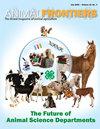牲畜对气候的适应
IF 3.2
2区 农林科学
Q1 AGRICULTURE, DAIRY & ANIMAL SCIENCE
引用次数: 0
摘要
本文章由计算机程序翻译,如有差异,请以英文原文为准。
Livestock adaptation to climate
Change and adaptation are the phenomena of life. Throughout the existence of life on earth, biological systems have adapted and changed physiologically and morphologically to acquire a homeostasis most suitable for the demands of the environment. The genetic composition is interchangeable among organisms, and the expressions of traits are the response genes in combination to biological requirements. Human interventions changed a plethora of gene expressions by direct selection including hunting, domestication, and selecting for desirable traits. Human interventions on the biological world are moving rapidly from direct to indirect interventions through overutilization of resources and secondary effects of industrial development on the earth’s ecosystems. Extensive livestock farming has developed to having a footprint in virtually every climate zone with the subtropics and temperate zones being the most favorable. The subtropics between 30 and 34 degrees north and south of the equator are accommodating for large and small animal species. The subtropics however have a range of ecological zones and microclimates shaped by geological and atmospheric features. The range of ecological zones includes extensive rangeland varying from high rainfall grasslands to semidesert scrub regions; dense and extended savannas, summer rainfall, and Mediterranean winter rainfall; summer mean temperature of 27 °C reaching >40 °C, while the winter daytime temperature range is 5 to 12 °C. Winter snowfalls can occur at higher altitudes as far north as the Tropic of Capricorn in the Southern Hemisphere. Periodic, prolonged droughts occur throughout the subtropical zone, which is influenced by the El Niño–La Niño phenomenon that occurs in the southeastern Pacific Ocean. This issue of Animal Frontiers, Livestock Adaptation to Climate, focuses on selected aspects of extensive livestock production: grassland and savanna, genetics of small stock and large stock, nutrition, and product quality.
求助全文
通过发布文献求助,成功后即可免费获取论文全文。
去求助
来源期刊

Animal Frontiers
Veterinary-Food Animals
CiteScore
6.50
自引率
5.60%
发文量
74
期刊介绍:
Animal Frontiers is the official journal of the following globally active professional animal science societies:
ASAS, the American Society of Animal Science
CSAS, the Canadian Society of Animal Science
EAAP, the European Federation of Animal Science
AMSA, the American Meat Science Association
These organizations are dedicated to the advancement and dissemination of science-based knowledge concerning animal agriculture. Animal Frontiers provides a novel forum for innovative and timely perspectives that have relevance to understanding the complex dynamics at work through animal agriculture. Animal Frontiers publishes discussion and position papers that present several international perspectives on the status of high-impact, global issues in animal agriculture. Every issue will explore a theme of broad and current interest within animal science and animal agriculture.
 求助内容:
求助内容: 应助结果提醒方式:
应助结果提醒方式:


